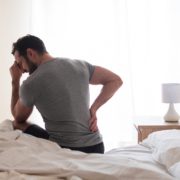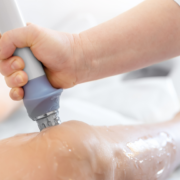How to Stay Injury-Free on the Golf Course This Season
Golf is a favorite pastime for millions – and now that the season is in full swing here in New England – many players are eager to hit the course as often as possible. But when back, knee, elbow, or shoulder pain creeps in – those 18 holes can quickly lose their appeal – and even become depressing. Pain doesn’t just interfere with your swing. It can drain the joy right out of your game.
The good news? Many of the injuries that golfers suffer from are preventable. With a bit of foresight, the right kind of movement, and smart preparation – you can keep your body strong and your game on point all season long.
Here are five of the most common injuries I see golfers facing – and what you can do to avoid or recover from them quickly:
1. Back Pain
This is by far the most frequent complaint among golfers. The constant bending, twisting, and rotational force of a golf swing can wreak havoc on your spine – especially if your back is stiff or you spend a lot of time sitting during the week.
The best way to keep your back pain-free? Focus on improving your spinal mobility – particularly extension and rotation. Even perfect swing mechanics can’t make up for a back that lacks movement. Try adding daily backward stretching and limit prolonged sitting – especially on the days you know you’ll be golfing. These small changes can make a big difference in keeping your spine mobile and resilient throughout the season.
2. Golfer’s Elbow (Medial Epicondylitis)
This injury happens when the tendons on the inside of your elbow become irritated – often due to repetitive swinging. But the root problem, however, frequently lies elsewhere. Weakness in your shoulder girdle or stiffness in your wrist can force your elbow to overcompensate.
To prevent and heal golfer’s elbow – don’t just focus on the elbow itself. Work on improving shoulder stability and wrist mobility as part of your regular conditioning. In more stubborn cases – regenerative therapies like Shockwave Therapy or EMTT can speed up healing and reduce inflammation – helping you stay on the course without resorting to cortisone shots or any downtime.
3. Knee Pain
Walking the course and rotating through your swing can put a lot of pressure on your knees – especially if you lack strength in your core and hips – or have unstable feet and ankles. Your knees aren’t designed to power your swing, but they often get overworked if other areas aren’t pulling their weight.
Most knee pain in golfers is mechanical, not structural. Meaning, it’s caused by faulty movement patterns rather than actual damage, even when imaging shows said “damage”. The good news? With the right strengthening and stabilization exercises, you can typically resolve your knee pain naturally – no injections or surgery required.
4. Rotator Cuff (Shoulder) Injuries
The rotator cuff is responsible for stabilizing your shoulder, and it’s highly involved during your golf swing. If it’s weak – or if your mid-back and core aren’t supporting it – your rotator cuff can easily become inflamed or irritated.
To prevent this, build strength not only in your shoulders, but also in your mid-back, lats, and core. These “powerhouse” muscles provide a solid foundation and reduce the strain on your shoulders. If your shoulder pain is persistent, regenerative Shockwave Therapy and EMTT (like in the case of golfer’s elbow) can be an excellent way to accelerate healing and reduce the need for medication, rest, or downtime.
5. Wrist and Hand Injuries
Sprains, strains, and other wrist or hand injuries are common in golf – often due to grip issues or poorly fitted equipment. But one commonly overlooked factor is your neck. Research shows that nearly half of all upper extremity pain can be traced back to the cervical spine – even if you don’t feel any neck pain.
If nerve irritation or stiffness in your neck is the true culprit – no amount of wrist strengthening will help – because the root cause has been missed. If your wrist or hand symptoms persist despite traditional mobility, strength and even manual work, it may be time for a full-body assessment by a mechanical pain specialist who can identify whether the issue is actually coming from somewhere else.
Final Thoughts
Golf injuries can be frustrating – but they’re often preventable and highly treatable when you know what to do or where to turn for the right help. By addressing problems early, using targeted movement strategies, and supporting your body with proper mechanics – you can keep playing pain-free all season long.
And when more advanced treatment is needed – especially for tendon or joint inflammation – non-invasive regenerative therapies like Shockwave Therapy and EMTT can offer fast, effective relief and accelerate recovery.
As a physical therapist who specializes in mechanical pain and movement dysfunction, I’ve helped countless golfers who thought their playing days were over – only to return to the course stronger and better than before. The key is addressing the true source of pain, not just masking the symptoms.
Dr. Carrie Jose, Physical Therapist and Mechanical Pain Expert, owns CJ Physical Therapy & Pilates in Portsmouth, NH and writes for Seacoast Media Group. To request one of her free guides for back or knee pain – visit her website: cjphysicaltherapy.com – or call 603-380-7902










